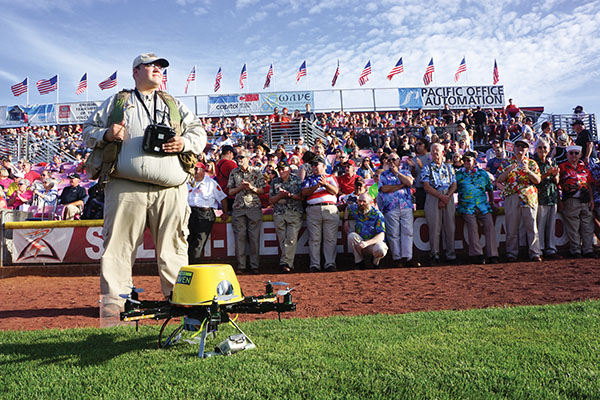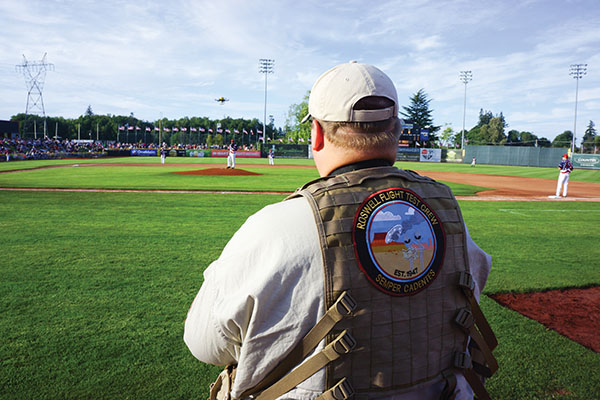If You Fly It, They Will Come
As the Roswell Flight Test Crew, my partner Brian Zvaigzne and I relish any opportunity to show off rotordrones in a positive light. So, when a local organization contacted us about delivering a small parcel as part of a public demonstration, we leapt at the chance. On the surface, it sounded like a pretty easy gig: the parcel was a sphere, approximately nine inches in circumference, weighing about 5 ounces. It contained a core made of rubber or cork, tightly wrapped in yarn and encased in two leather halves, bound up with 108 stitches — in other words, a regulation American League baseball!
The distance over which we had to deliver this package was similarly modest: only about 60 feet, the distance from home plate to the pitcher’s mound. It’s only when you put those two together, and then schedule this demonstration for the 4th of July (in a packed baseball stadium), that the magnitude of the task becomes clear: we were being asked to “fly out” the first pitch.
Above: Brian Zvaigzne and RQCX-3 Raven wait just outside the first base line for the Roswell Flight Test Crew’s main contribution to the event: “flying out the first pitch,” by picking up a baseball from the umpire at home plate and flying it out to the pitcher.
If you fly it, they will come
This unique request came from Jerry Howard, who has devoted his entire life to the sport of baseball and is currently the Director of Game Day Operations for the Salem-Keizer Volcanoes, a Class-A affiliate of the San Francisco Giants.
We arranged to meet with him in early April before the start of the season to test the practicality of our planned demonstration. We settled on a clear plastic bucket attached to a thin carbon-fiber rod hanging below our Raven multirotor to carry the ball. We recognized that we would have to fly this mission “eyes on” as First-Person View simply wouldn’t provide the pinpoint precision and overall situational awareness required to successfully complete this maneuver. Also, it was clear that we would need our best pilot on the job, so I deferred to the other half of the Test Crew, Brian Zvaigzne.
Playing the role of the umpire, Jerry stood at home plate while I took to the pitcher’s mound. Brian positioned himself about halfway down the first base line and pushed Raven out toward Jerry. It was clear that depth perception — judging the distance between the aircraft and the people on the field — was going to be an issue, but after a few attempts, Brian was definitely getting better at it.
Jerry was easily able to drop the ball in the bucket, but it was a little more difficult for me to get it back out. During one attempt, I simply grabbed hold of the bucket, but that caused Raven to lean over about 30 degrees to one side, attempting to right itself. Brian was unable to manually level the aircraft, and if I let go, it would have shot off in the direction of the stands.
No doubt she would have found her center again at some point, but that definitely wasn’t going to be an option on game day. I reached out and got a firm grip on her undercarriage, and then Brian spun down her motors. It was clear that we still had some work to do.
Game day
We used the months between that initial trial run and July 4 to practice and refine our technique, until we were confident that we could perform the required maneuvers safely and reliably. Jerry assured us that we would have the opportunity to practice with the umpire and the pitcher in the hours leading up to the game.
Arriving early, we set up our ground station just beyond the outfield fence, near a gate that would provide us with easy access to the field. We did a few quick rehearsals, with me running back and forth between home plate and the pitcher’s mound to play both roles. Everything was ready to go.
About an hour before the pre-game festivities got underway, I started looking for the people who would actually be performing with our rotordrone. “We’ve got a problem,” one of Jerry’s helpers said. “The umpire isn’t here yet. He’s running late.”
My heart started beating a little faster, but I still wasn’t overly concerned: the umpire had an easy job. Anybody can drop a ball in a bucket, I persuaded myself.
“What about the pitcher. Is he here?” I asked.
“Yes, he’s in the locker room,” he answered.
“Great! Can I talk to him?”
“No.”
“Why not!?”
“He doesn’t speak English. We’re trying to find someone who can translate for him. What is it, exactly, that he needs to do again?”
Above: Successfully ferrying the first pitch from home plate to the pitcher’s mound required pilot Brian Zvaigzne to precisely judge the distance between the aircraft and the people on the field. Here, he guides RQCX-3 Raven through a slow descent over pitcher Jose Reyes to deliver the game ball.
Play ball!
That was how we came to find ourselves standing on the side of a baseball field, surrounded by 6,000 fans who had turned up to watch a drone fly out the first pitch on the Fourth of July — with an umpire and a pitcher who had never even seen a multirotor before. Brian spun up Raven’s motors and lifted it into the air, then sent it off slowly in the direction of home plate. The umpire watched skeptically as our buzzing machine approached.
Raven overshot him, provoking a chuckle from the crowd as it circled back around to collect the ball. He dropped it into the bucket, and Brian moved the drone laterally out toward the pitcher’s mound. I watched intently, ready to sprint out onto the field if the pitcher snagged the bucket and set Raven teetering off in the direction of the crowd.
Fortunately, my instructions not to grab the bucket had apparently survived the translation, and he gingerly reached in and grabbed the ball, without ever having to shift his footing on the mound — a remarkable testament to Brian’s skills as a pilot.
With the payload delivered, Brian lifted Raven up, up, and away before bringing it safely back to the ground at our feet. I scooped Raven up and we hurried back to our ground station, clearing the field so that the game could get underway.
That afternoon, the Volcanoes squared off against the Hillsboro Hops. Although the Hops had a much better record going into the game, the home team prevailed, winning by a decisive 5 to 1. I’m sure that the issue will be debated by commentators for decades to come, but I’d like to think that we played some small part in that victory, by giving the Volcanoes a little “lift” ahead of the game. Ahem.





















